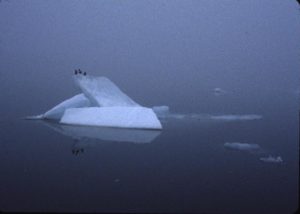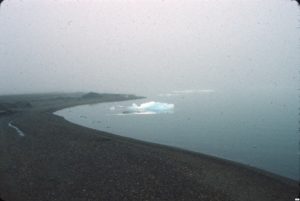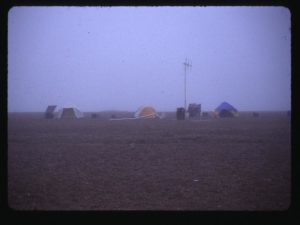We put thirty spokes together and call it a wheel;
But it is on the space where there is nothing that the usefulness of the wheel depends.
We turn clay to make a vessel;
But it is on the space where there is nothing that the usefulness of the vessel depends.
We pierce doors and windows to make a house;
And it is on these spaces where there is nothing that the usefulness of the house depends.
Therefore just as we take advantage of what is, we should recognize the usefulness of what is not. Dao de jing
29 July 2000, Cooper Island, Alaska
I’ve been walking since I got up this morning, and eating, of course. The wind and rain of the other day finally passed. Yesterday was foggy and freezing; everything was covered with a thin sheet of ice. The fog lifted briefly in the afternoon and it was warm. This morning when I awoke the air was absolutely dead calm, the fog as thick as it has ever been. And so, I walked.
There is silence and stillness to this fog world that is unmatched. Even intensely cold days in the north woods have sound and a feeling of motion: the creak of ice laden branches as they sway under their burdens, the crunch of sub-zero-temperature snow underfoot. This Arctic fog stillness is absolute.
To stand on the edge of the water and look into the gray void created by the sky and water uniting in color and texture is to truly experience sensory deprivation. Except for a few birds, my footsteps, and the almost imperceptible wash of water on the shore there is no sound, even these few things you must work to hear. All sense of sight is gone; the utterly calm water perfectly mirrors the sky, eliminating any evidence of a boundary between them. Without an automatic brain override of the fog, I would think I was losing my sight.

Black guillemots on ice floe
Now and then, on the lagoon side of the island, a dark spot that is a loon or a long-tailed duck will break free of the fog and show itself, giving definitive life to the water and proving that there is more than one dimension. On the ocean side, ice floes loom, moving imperceptibly; they often calve. The sound, that distorted fog sound, travels across the water. In the ocean there is no change, no motion, and no acknowledgement by the water or the air that the ice balance has shifted. Only silence once again.
Occasionally a red-throated loon gives its eerie, raspy, almost desperate call. No loon is in sight but I know it is among the ice floes, bill pointed to the foggy sky, head cocked to one side, listening into the silence for an answer. Listening for any sound at all, some proof that the rest of the world still exists. Is it only in our imagination that there was once wind and motion, sounds of water washing against the shore, or the persistent calls of numerous other birds?
I attempted many photos of this deprivation, some hard fast object in the foreground with the limitless depths of fog-gray-void behind. How does one record the lack of something to see? I’m not sure. If there is anything in these photos, any depth or contrast, any color, any motion, they will be stupendous indeed. In many ways this is the essence of my purpose here, to record that which is not plainly visible, to show that despite this seeming void, life thrives just out of view, and that there is usefulness in that which we cannot see and do not know.


